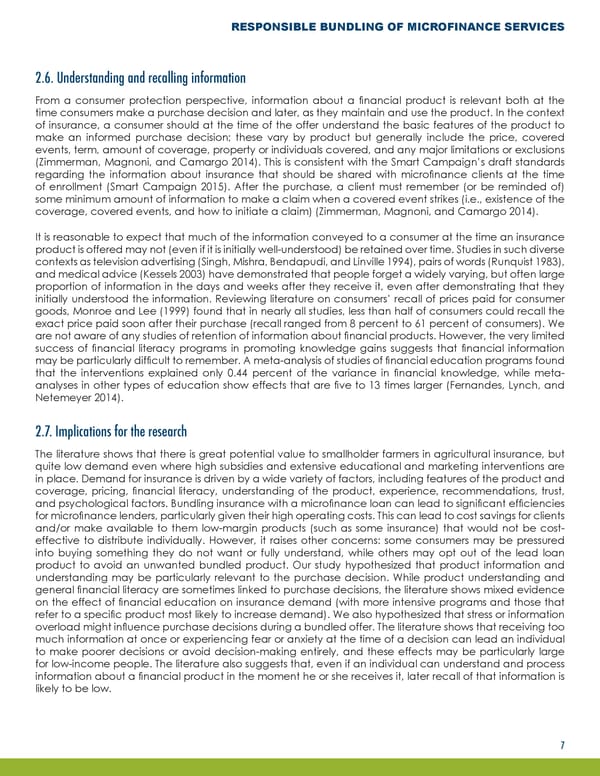RESPONSIBLE BUNDLING OF MICROFINANCE SERVICES 2.6. Understanding and recalling information From a consumer protection perspective, information about a financial product is relevant both at the time consumers make a purchase decision and later, as they maintain and use the product. In the context of insurance, a consumer should at the time of the offer understand the basic features of the product to make an informed purchase decision; these vary by product but generally include the price, covered events, term, amount of coverage, property or individuals covered, and any major limitations or exclusions (Zimmerman, Magnoni, and Camargo 2014). This is consistent with the Smart Campaign’s draft standards regarding the information about insurance that should be shared with microfinance clients at the time of enrollment (Smart Campaign 2015). After the purchase, a client must remember (or be reminded of) some minimum amount of information to make a claim when a covered event strikes (i.e., existence of the coverage, covered events, and how to initiate a claim) (Zimmerman, Magnoni, and Camargo 2014). It is reasonable to expect that much of the information conveyed to a consumer at the time an insurance product is offered may not (even if it is initially well-understood) be retained over time. Studies in such diverse advertising (Singh, Mishra, Bendapudi, and Linville 1994), pairs of words (Runquist 1983), contexts as television and medical advice (Kessels 2003) have demonstrated that people forget a widely varying, but often large proportion of information in the days and weeks after they receive it, even after demonstrating that they initially understood the information. Reviewing literature on consumers’ recall of prices paid for consumer goods, Monroe and Lee (1999) found that in nearly all studies, less than half of consumers could recall the exact price paid soon after their purchase (recall ranged from 8 percent to 61 percent of consumers). We are not aware of any studies of retention of information about financial products. However, the very limited success of financial literacy programs in promoting knowledge gains suggests that financial information may be particularly difficult to remember. A meta-analysis of studies of financial education programs found that the interventions explained only 0.44 percent of the variance in financial knowledge, while meta- analyses in other types of education show effects that are five to 13 times larger (Fernandes, Lynch, and Netemeyer 2014). 2.7. Implications for the research The literature shows that there is great potential value to smallholder farmers in agricultural insurance, but quite low demand even where high subsidies and extensive educational and marketing interventions are in place. Demand for insurance is driven by a wide variety of factors, including features of the product and coverage, pricing, financial literacy, understanding of the product, experience, recommendations, trust, and psychological factors. Bundling insurance with a microfinance loan can lead to significant efficiencies for microfinance lenders, particularly given their high operating costs. This can lead to cost savings for clients and/or make available to them low-margin products (such as some insurance) that would not be cost- effective to distribute individually. However, it raises other concerns: some consumers may be pressured into buying something they do not want or fully understand, while others may opt out of the lead loan product to avoid an unwanted bundled product. Our study hypothesized that product information and understanding may be particularly relevant to the purchase decision. While product understanding and general financial literacy are sometimes linked to purchase decisions, the literature shows mixed evidence on the effect of financial education on insurance demand (with more intensive programs and those that refer to a specific product most likely to increase demand). We also hypothesized that stress or information overload might influence purchase decisions during a bundled offer. The literature shows that receiving too much information at once or experiencing fear or anxiety at the time of a decision can lead an individual to make poorer decisions or avoid decision-making entirely, and these effects may be particularly large for low-income people. The literature also suggests that, even if an individual can understand and process information about a financial product in the moment he or she receives it, later recall of that information is likely to be low. 7
 Responsible Bundling of Microfinance Services Page 9 Page 11
Responsible Bundling of Microfinance Services Page 9 Page 11